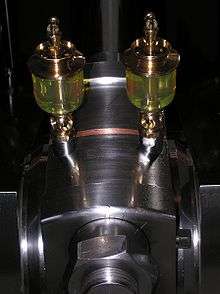Lubrication
Lubrication is the process or technique of using a lubricant to reduce friction and wear and tear in a contact between two surfaces. The study of lubrication is a discipline in the field of tribology.

Lubricants can be solids (such as molybdenum disulfide MoS2),[1] solid/liquid dispersions (such as grease), liquids (such as oil or water), liquid-liquid dispersions or gases.
Fluid-lubricated systems are designed so that the applied load is partially or completely carried by hydrodynamic or hydrostatic pressure, which reduces solid body interactions (and consequently friction and wear). Depending on the degree of surface separation, different lubrication regimes can be distinguished.
Adequate lubrication allows smooth, continuous operation of machine elements, reduces the rate of wear, and prevents excessive stresses or seizures at bearings. When lubrication breaks down, components can rub destructively against each other, causing heat, local welding, destructive damage and failure.
Lubrication mechanisms
Fluid-lubricated systems
As the load increases on the contacting surfaces, three distinct situations can be observed with respect to the mode of lubrication, which are called lubrication regimes:
- Fluid film lubrication is the lubrication regime in which, through viscous forces, the load is fully supported by the lubricant within the space or gap between the parts in motion relative to one another object (the lubricated conjunction) and solid–solid contact is avoided.[2]
- In hydrostatic lubrication, external pressure is applied to the lubricant in the bearing to maintain the fluid lubricant film where it would otherwise be squeezed out.
- In hydrodynamic lubrication, the motion of the contacting surfaces, as well as the design of the bearing, pump lubricant around the bearing to maintain the lubricating film. This design of bearing may wear when started, stopped or reversed, as the lubricant film breaks down. The basis of the hydrodynamic theory of lubrication is the Reynolds equation. The governing equations of the hydrodynamic theory of lubrication and some analytical solutions can be found in the reference.[3]
- Elastohydrodynamic lubrication: Mostly for nonconforming surfaces or higher load conditions, the bodies suffer elastic strains at the contact. Such strain creates a load-bearing area, which provides an almost parallel gap for the fluid to flow through. Much as in hydrodynamic lubrication, the motion of the contacting bodies generates a flow induced pressure, which acts as the bearing force over the contact area. In such high pressure regimes, the viscosity of the fluid may rise considerably. At full film elastohydrodynamic lubrication the generated lubricant film completely separates the surfaces. Contact between raised solid features, or asperities, can occur, leading to a mixed-lubrication or boundary lubrication regime. In addition to Reynolds equation, elastohydrodynamic theory considers the elastic deflection equation, since in this regime elastic deformation of the surfaces contributes significantly to the lubricant film thickness.[4][5]
- Boundary lubrication[6] (also called boundary film lubrication): The hydrodynamic effects are negligible. The bodies come into closer contact at their asperities; the heat developed by the local pressures causes a condition which is called stick-slip, and some asperities break off. At the elevated temperature and pressure conditions, chemically reactive constituents of the lubricant react with the contact surface, forming a highly resistant tenacious layer or film on the moving solid surfaces (boundary film) which is capable of supporting the load and major wear or breakdown is avoided. Boundary lubrication is also defined as that regime in which the load is carried by the surface asperities rather than by the lubricant.[7]
- Mixed lubrication: This regime is in between the full film elastohydrodynamic and boundary lubrication regimes. The generated lubricant film is not enough to separate the bodies completely, but hydrodynamic effects are considerable.[8]
Besides supporting the load the lubricant may have to perform other functions as well, for instance it may cool the contact areas and remove wear products. While carrying out these functions the lubricant is constantly replaced from the contact areas either by the relative movement (hydrodynamics) or by externally induced forces.
Lubrication is required for correct operation of mechanical systems such as pistons, pumps, cams, bearings, turbines, cutting tools etc. where without lubrication the pressure between the surfaces in close proximity would generate enough heat for rapid surface damage which in a coarsened condition may literally weld the surfaces together, causing seizure.
In some applications, such as piston engines, the film between the piston and the cylinder wall also seals the combustion chamber, preventing combustion gases from escaping into the crankcase.
If an engine required pressurised lubrication to, say, plain bearings, there would be an oil pump and an oil filter. On early engines (such as a Sabb marine diesel), where pressurised feed was not required splash lubrication would suffice.
See also
References
- http://www.engineersedge.com/lubrication/applications_solid_lubrication.htm – 14k
- San Andrés. L. "Introduction to pump rotordynamics, Part i. Introduction to hydrodynamic lubrication". ("MEEN626 Lubrication Theory Class:Syllabus FALL2006"). (11 Dec 2007)
- tribonet (2017-02-16). "Hydrodynamic Lubrication". Tribology. Retrieved 2017-02-23.
- tribonet (2017-02-05). "Elastohydrodynamic Lubrication (EHL)". Tribology. Retrieved 2017-02-23.
- Popova, E.; Popov, V. L. (2015). "On the history of elastohydrodynamics: The dramatic destiny of Alexander Mohrenstein-Ertel and his contribution to the theory and practice of lubrication". Zeitschrift für Angewandte Mathematik und Mechanik. 95 (7): 652–663. doi:10.1002/zamm.201400050.
- Ewen, James. "Boundary Lubrication". Trbonet.
- Bosman R. and Schipper D.J. Microscopic Mild Wear in the Boundary Lubrication regime. Laboratory for Surface Technology and Tribology, Faculty of Engineering Technology, University of Twente, P.O. Box 217, NL 7500 AE Enschede, The Netherlands.
- Akchurin, Aydar; Bosman, Rob; Lugt, Piet M.; Drogen, Mark van (2015-05-31). "On a Model for the Prediction of the Friction Coefficient in Mixed Lubrication Based on a Load-Sharing Concept with Measured Surface Roughness". Tribology Letters. 59 (1): 19. doi:10.1007/s11249-015-0536-z. ISSN 1023-8883.
External links
| Wikimedia Commons has media related to Lubrication. |
| Look up lubrication in Wiktionary, the free dictionary. |